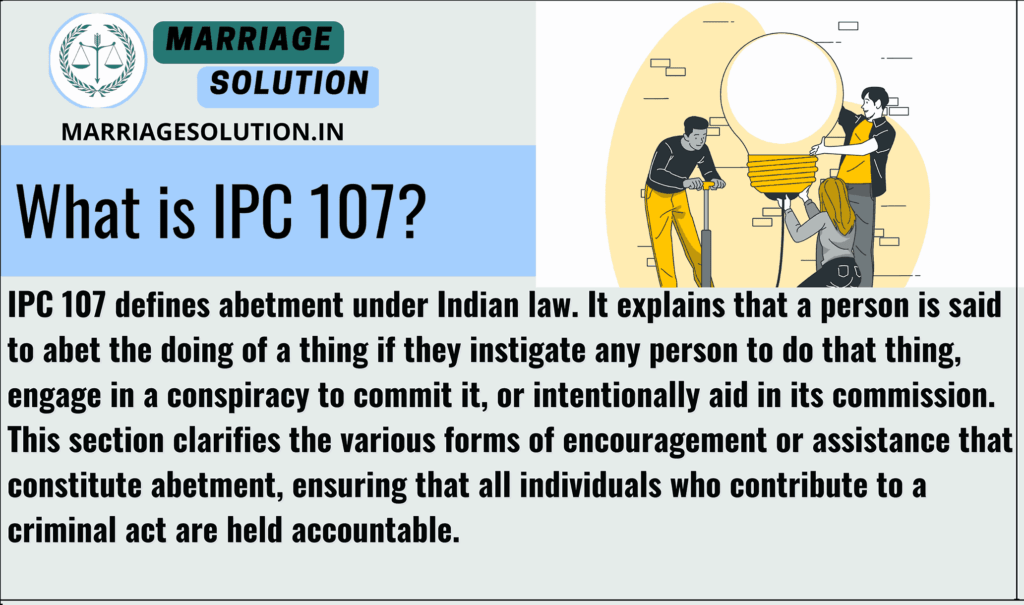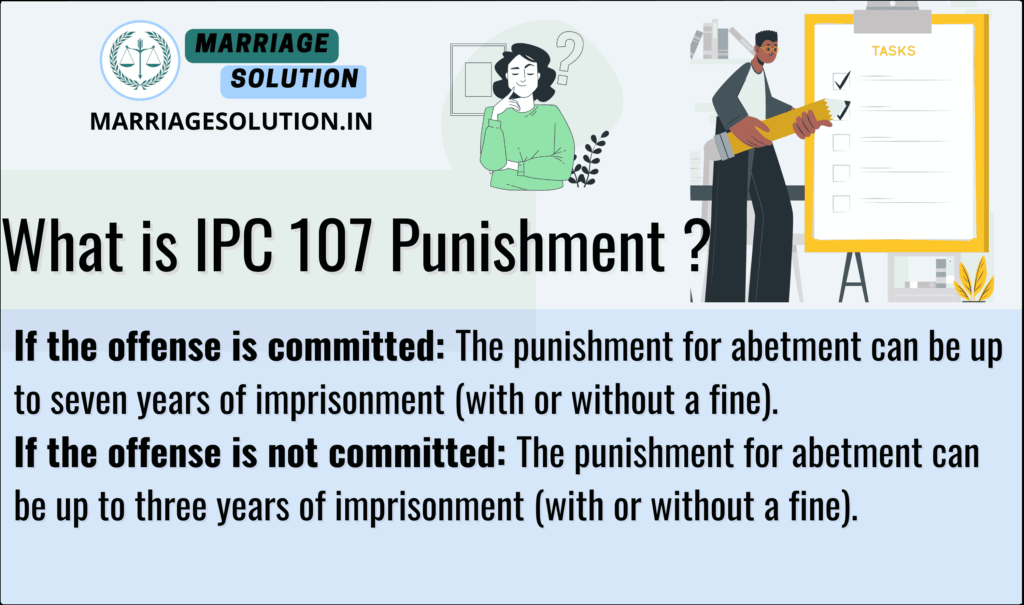Introduction of 107 IPC
IPC Section 107 explains the concept of abetment in Indian law. It defines how a person can be held responsible for instigating, conspiring, or aiding another person in committing a crime.
- Introduction of 107 IPC
- What is IPC Section 107 ?
- IPC Section 107 Overview
- Section 107 IPC Punishment
- 107 of IPC bailable or not ?
- Section 107 IPC case laws
- IPC Section 107 A: Abetment by Conspiracy
- IPC Section 107 B: Abetment by Instigation
- IPC Section 107 C: Abetment by Aiding
- IPC Section 107 D: Abetment Without Crime
- Section 107 IPC in short information
- 107 IPC FAQs
- If you need support with court proceedings or any other legal matters, don’t hesitate to reach out for assistance.
What is IPC Section 107 ?
IPC 107 defines abetment under Indian law. It explains that a person is said to abet the doing of a thing if they instigate any person to do that thing, engage in a conspiracy to commit it, or intentionally aid in its commission. This section clarifies the various forms of encouragement or assistance that constitute abetment, ensuring that all individuals who contribute to a criminal act are held accountable.

IPC Section 107 Overview
IPC Section 107 explains the concept of abetment in Indian law. It defines how a person can be held responsible for instigating, conspiring, or aiding another person in committing a crime.
Key Points of IPC Section 107
- Definition of Abetment
- Explanation: IPC Section 107 defines abetment as encouraging, instigating, or aiding another person to commit a crime. This can be done through words, actions, or even gestures.
- Three Ways of Abetment
- Explanation: Abetment can occur in three ways:
- Instigation: Provoking or inciting someone to commit an offense.
- Conspiracy: Involvement in planning with one or more people to commit an offense.
- Aiding: Assisting in committing the offense, either before or during the act.
- Explanation: Abetment can occur in three ways:
- Intent is Key
- Explanation: For an act to be considered abetment, the person must have the intention to instigate, conspire, or aid in committing the offense. Without intent, the act does not qualify as abetment.
- Punishment Linked to Main Offense
- Explanation: The punishment for abetment is usually linked to the punishment for the main offense. If the abetted offense is committed, the abettor faces similar penalties.
- Abetment Without Committing the Offense
- Explanation: Even if the main offense is not committed, a person can be punished for abetment if it is proven that they encouraged or aided the crime.
- Scope of Abetment
- Explanation: Abetment can apply to various offenses, from minor crimes to serious offenses like murder or robbery. The severity of the punishment depends on the seriousness of the abetted offense.
Section 107 IPC Punishment
If the offense is committed: The punishment for abetment can be up to seven years of imprisonment (with or without a fine).
If the offense is not committed: The punishment for abetment can be up to three years of imprisonment (with or without a fine).

107 of IPC bailable or not ?
IPC Section 107 offenses are generally bailable. However, whether bail is granted depends on the nature of the abetted offense. For serious crimes like murder, bail may not be granted easily, while for minor offenses, bail is more likely to be given.
Section 107 IPC case laws
Case 1: Mahbub Shah v. King Emperor (1945)
- Background: Accused charged with abetment in a murder case.
- Issue: Whether mere presence and non-interference constitute abetment.
- Judgment: Supreme Court acquitted the accused.
- Reasoning: Presence at the scene does not imply abetment without active participation or encouragement.
- Significance: Establishes that mere presence is not sufficient for abetment.
- Learning: Active participation or clear encouragement is necessary for abetment.
Case 2: Kartar Singh v. State of Punjab (1994)
- Background: Accused involved in abetting terrorist activities.
- Issue: Whether aiding terrorists constitutes abetment.
- Judgment: Supreme Court upheld the conviction.
- Reasoning: Providing support to terrorists amounts to abetment.
- Significance: Clarified that aiding and supporting criminal activities falls under abetment.
- Learning: Support and assistance in crimes are punishable under abetment.
Case 3: Faguna Kanta Nath v. State of Assam (1959)
- Background: Accused charged with abetment of a public servant’s misconduct.
- Issue: Whether indirect instigation constitutes abetment.
- Judgment: Supreme Court convicted the accused.
- Reasoning: Indirect instigation and involvement were sufficient for abetment.
- Significance: Indirect actions can also amount to abetment.
- Learning: Abetment can occur through indirect means.
Case 4: State of Maharashtra v. Kashirao (2002)
- Background: Accused charged with abetment of suicide.
- Issue: Whether continuous harassment constitutes abetment.
- Judgment: Court upheld the conviction.
- Reasoning: Continuous harassment leading to suicide is abetment.
- Significance: Persistent negative actions can constitute abetment.
- Learning: Continuous harassment can be considered abetment.
Case 5: Ram Kumar v. State of Haryana (2006)
- Background: Accused charged with abetment of theft.
- Issue: Whether providing tools for theft constitutes abetment.
- Judgment: Court convicted the accused.
- Reasoning: Providing means to commit theft amounts to abetment.
- Significance: Supplying tools for a crime is abetment.
- Learning: Facilitating the means for a crime is punishable as abetment.
Case 6: Sanjay v. State of Maharashtra (2007)
- Background: Accused charged with abetment of murder.
- Issue: Whether instigating a minor to commit murder constitutes abetment.
- Judgment: Supreme Court upheld the conviction.
- Reasoning: Instigating a minor is serious abetment.
- Significance: Instigating vulnerable individuals is severe abetment.
- Learning: Influencing minors to commit crimes is harshly punished.
Case 7: Sohan Lal v. State of Rajasthan (2011)
- Background: Accused charged with abetment of dowry death.
- Issue: Whether demanding dowry constitutes abetment.
- Judgment: Supreme Court convicted the accused.
- Reasoning: Dowry demands leading to death amount to abetment.
- Significance: Dowry-related harassment is abetment.
- Learning: Abetment covers actions leading to dowry deaths.
Case 8: Rashmi Rekha Thatoi v. State of Orissa (2012)
- Background: Accused charged with abetment of fraud.
- Issue: Whether aiding in fraudulent transactions constitutes abetment.
- Judgment: Court upheld the conviction.
- Reasoning: Assisting in fraud is abetment.
- Significance: Aiding financial fraud is abetment.
- Learning: Financial crimes through assistance are abetment.
Case 9: Amalendu Pal v. State of West Bengal (2010)
- Background: Accused charged with abetment of domestic violence.
- Issue: Whether encouraging domestic violence constitutes abetment.
- Judgment: Supreme Court convicted the accused.
- Reasoning: Encouragement and support for domestic violence are abetment.
- Significance: Domestic violence encouragement is severe abetment.
- Learning: Encouraging domestic violence is severely punishable.
Case 10: Sanjay Singh v. State of Uttar Pradesh (2014)
- Background: Accused charged with abetment of drug trafficking.
- Issue: Whether aiding in drug trafficking constitutes abetment.
- Judgment: Court upheld the conviction.
- Reasoning: Aiding drug trafficking is serious abetment.
- Significance: Drug-related crimes with aid are abetment.
- Learning: Facilitating drug trafficking is harshly punished
IPC Section 107 A: Abetment by Conspiracy
- Definition: Abetment by conspiracy involves planning with one or more people to commit an offense.
- Essential Elements: Requires a mutual agreement and shared intent among conspirators to commit the crime.
- Proof of Agreement: There must be clear evidence of an agreement or plan to commit the crime.
- Overt Act: At least one overt act in furtherance of the conspiracy must be performed.
- Shared Responsibility: All participants in the conspiracy are equally liable, irrespective of their specific roles.
- Intent: The conspirators must have a common intention to commit the crime.
- Scope: Includes both direct and indirect participation in the conspiracy.
- Legal Consequences: Conspirators face the same punishment as the primary offenders if the crime is executed.
IPC Section 107 B: Abetment by Instigation
- Definition: Abetment by instigation involves provoking or encouraging someone to commit a crime.
- Means of Instigation: Can occur through words, gestures, or any form of communication.
- Intent to Provoke: The person must have the intention to provoke the commission of the crime.
- Effect of Instigation: The crime must be committed as a direct result of the instigation.
- Evidence Requirement: Clear evidence of the instigation and its impact is necessary for conviction.
- Punishment: The instigator faces similar punishment to the primary offender if the crime is committed.
- Examples: Often seen in cases of incitement to violence or illegal activities.
- Legal Protection: Provides a framework to punish individuals who incite others to commit crimes.
IPC Section 107 C: Abetment by Aiding
- Definition: Abetment by aiding involves assisting in the commission of a crime.
- Types of Aid: Can include physical assistance, providing tools, or offering advice.
- Proof of Assistance: There must be clear evidence of actual assistance provided.
- Intent to Assist: The person aiding must have the intention to facilitate the crime.
- Extent of Aid: The level of aid provided can influence the severity of the punishment.
- Participation: Aiders are liable even if they do not participate directly in the crime.
- Punishment: Similar to the primary offender if the crime is committed.
- Legal Implications: Ensures that those who help in the commission of crimes are held accountable.
IPC Section 107 D: Abetment Without Crime
- Definition: Covers situations where abetment occurs, but the main crime is not committed.
- Intent and Actions: The abettor’s intent and actions are still punishable, even if the crime is not completed.
- Proof of Abetment: Requires clear evidence of instigation, conspiracy, or aiding.
- Punishment: Generally less severe than if the main crime had been committed.
- Legal Consequences: Ensures abettors cannot escape punishment due to the non-commission of the crime.
- Preventive Measure: Acts as a deterrent against encouraging criminal behavior.
- Judicial Discretion: Courts can decide the appropriate punishment based on the circumstances.
- Significance: Reinforces accountability for encouraging or planning crimes, even if the crime does not take place.
Section 107 IPC in short information
| Offence | Definition | Punishment | Bailable or Not |
|---|---|---|---|
| Abetment | Encouraging, instigating, or aiding someone to commit a crime | Same as the main offense if committed; imprisonment and fines if not | Generally bailable, but depends on the nature of the abetted offense |
107 IPC FAQs
What is abetment under IPC Section 107?
Abetment under IPC 107 involves instigating, conspiring, or aiding someone to commit a crime.
What are the ways of committing abetment?
Abetment can be committed by instigating, engaging in conspiracy, or aiding the commission of an offense.
Can someone be punished for abetment if the main crime is not committed?
Yes, even if the main crime is not committed, the abettor can still face punishment under IPC 107.
Is abetment a bailable offense?
Generally, abetment is bailable, but the nature of the main offense influences the decision on granting bail.
If you need support with court proceedings or any other legal matters, don’t hesitate to reach out for assistance.
Court or any other marriage-related issues, our https://marriagesolution.in/lawyer-help-1/ website may prove helpful. By completing our enquiry form and submitting it online, we can provide customized guidance to navigate through the process effectively. Don’t hesitate to contact us for personalized solutions; we are here to assist you whenever necessary!
